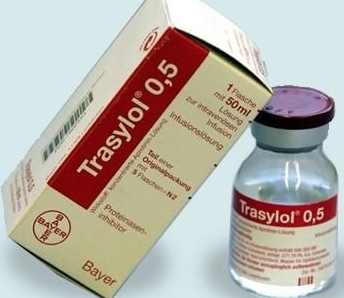阿尼普酶(茵香酞化纖溶酶原一鏈激酶激活劑)為纖溶酶原和鏈激酶激活劑複合物的乙酞化物。在體內經脫酞化作用,自發恢復激活纖溶酶原的作用。本品半衰期可延長到90min ,可快速靜脈注射並延長溶栓作用時間,是治療急性心肌梗死安全而有效的藥物,可降低再阻塞率,改善左室功能,提高近期和遠期存活率。本品對血凝塊無選擇性,大劑量可致低凝狀態或出血。也可引起過敏反應。
基本介紹
- 中文名:阿尼普酶
- 外文名:Anistreplase
- 中文別名:前尿激酶
- 全稱:茵香酞化纖溶酶原一鏈激酶激活劑
通用名稱,藥理作用,適應症狀,用法用量,注意事項,不良反應,相互作用,
通用名稱
通用名稱:阿尼普酶
 阿尼普酶
阿尼普酶藥理作用
Classification: Thrombolytic enzyme
Action/Kinetics: Prepared by acylating human plasma derived from lys-plasminogen and purified streptokinase derived from group C beta-hemolytic streptococci. When prepared, anistreplase is an inactive derivative of a fibrinolytic enzyme although the compound can still bind to fibrin. Anistreplase is activated by deacylation and subsequent release of the anisoyl group in the blood stream. The production of plasmin from plasminogen occurs in both the blood stream and the thrombus leading to thrombolysis. Lyses thrombi obstructing coronary arteries and reduces the size of infarcts. t1/2: 70-120 min.
適應症狀
Management of AMI in adults, resulting in improvement of ventricular function and reduction of mortality. Treatment should be initiated as soon as possible after the onset of symptoms of AMI.
用法用量
IV only: 30 units over 2-5 min into an IV line or vein as soon as possible after onset of symptoms.
注意事項
Pregnancy Category: C
Contraindications: Use in active internal bleeding; within 2 months of intracranial or intraspinal surgery; recent trauma, including cardiopulmonary resuscitation; history of CVA; intracranial neoplasm; arteriovenous malformation or aneurysm; known bleeding diathesis; severe, uncontrolled hypertension; severe allergic reactions to streptokinase.
Special Concerns: Use with caution in nursing mothers. Safety and effectiveness have not been determined in children. NOTE: The risks of anistreplase therapy may be increased in the following conditions; thus, benefit versus risk must be assessed prior to use. Within 10 days of major surgery (e.g., CABG, obstetric delivery, organ biopsy, previous puncture of noncompressible vessels); cerebrovascular disease; within 10 days of GI or GU bleeding; within 10 days of trauma including cardiopulmonary resuscitation; SBP > 180 mm Hg or DBP > 110 mm Hg; likelihood of left heart thrombus (e.g., mitral stenosis with atrial fibrillation); SBE; acute pericarditis; hemostatic defects including those secondary to severe hepatic or renal disease; pregnancy; clients older than 75 years of age; diabetic hemorrhagic retinopathy or other hemorrhagic ophthalmic conditions; septic thrombophlebitis or occluded arteriovenous cannula at seriously infected site; clients on oral anticoagulant therapy; any condition in which bleeding constitutes a significant hazard or would be difficult to manage due to its location.
不良反應
Bleeding: Including at the puncture site (most common), nonpuncture site hematoma, hematuria, hemoptysis, GI hemorrhage, intracranial bleeding gum/mouth hemorrhage, epistaxis, anemia, eye hemorrhage. CV: Arrhythmias conduction disorders, hypotension; cardiac rupture chest pain, emboli (causal relationship to use of anistreplase unknown). Allergic: Anaphylaxis, bronchospasm angioedema, urticaria, itching, flushing, rashes, eosinophilia, delayed purpuric rash which may be associated with arthralgia, ankle edema, mild hematuria, GI symptoms, and proteinuria. GI: N&V. Hematologic: Thrombocytopenia. CNS: Agitation, dizziness, paresthesia, tremor, vertigo. Respiratory: Dyspnea, lung edema. Miscellaneous: Chills, fever, headache, shock.
相互作用
Increased risk of bleeding or hemorrhage if used with heparin, oral anticoagulants, vitamin K antagonists, aspirin, or dipyridamole.
